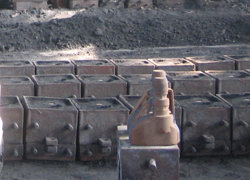| |
The Performance Requirements and Testing Methods of Green Sand
High-quality foundry sand should have
different and necessary prosperities for good metal castings.
According to casting alloy type, casting size, thickness, pouring
temperature, metal hydraulic head, sand compaction methods, gating
system shape, position, and vents, as well as dry conditions of sand
surface and so on, different performance requirements on green sand
are proposed.
Among them, the most important, which directly affect casting
quality and wet performance of the molding process are water,
permeability, strength, compaction rate, deformation, broken index,
mobility, clay content, effective clay content, particle
composition, Myanmar compounds, sand temperature, gas evolution,
effective coal content, loss on ignition, anti-sand, anti-sticky
sand and so on.
This article mainly discusses five
performance requirements and testing methods.
1. Water
In order to get the required wet strength and toughness, clay sand
must contain the right amount of water, too dry or too wet are not
suitable for modeling, and it is difficult to cast qualified
castings. Therefore, the wet and dry extent of green sand must be
kept in a suitable range.
2. Permeability
Compact sand can let the gas escape and this ability is known as
permeability. The level of permeability is mainly affected by the
sand size, size distribution, grain shape, clay content, the binder
type, its added quantity and the binder distribution in the sand and
effects of sand compaction. For single wet sand and facing sand, the
permeability should not only have a lower limit, but also strictly
define the upper limits.
3. Wet strength
Foundry sand must have certain strength to withstand various
external forces. The sand strength is expressed by the stress value
of standard sample under destruction of external force. The common
units of measurement are MPa or kPa. In wet casting, we often
examination the test wet compressive strength and also measure the
wet shear strength and wet tensile strength. In the production, we
often use surface hardness tester to measure hardness, which
reflects the quality of sand compaction and the strength of the mold
surface.
4. Mobility
In force or under gravity, sand moves relatively between the
appearance and the sand, this ability is known as liquidity. Sand
with good mobility can form cavity of even compaction, no local
loose, clean cut, smooth surface, which helps prevent mechanical
sticky sand and get smooth castings. In addition, it can also reduce
labor intensity and improve productivity and facilitate the
realization of mechanization of moulding and core-making process.
5. Gas evolution and effective coal
dust content
In order to check the iron castings’ ability to resist mechanical
sticky sand and calculate the effective coal content of sand, gas
evolution test is the common method used in China. Gas-forming
property (gas evolution) are mostly used to test the gasification of
the sample heated in a closed system or the volume of gas produced,
or to measure the gas pressure, or weigh the residue quality to
determine gas evolution.
High-quality foundry sand plays an important role in metal casting,
so we should choose the good green sand and produce better castings.

Home |
More Articles |
|
